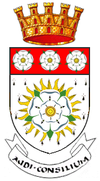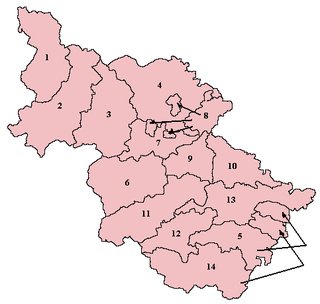- West Riding of Yorkshire
-
For the former parliamentary constituency, see West Riding of Yorkshire (UK Parliament constituency).
County of York, West Riding Motto: Audi consilium (Heed Council)[1] 
West Riding shown within EnglandGeography Status Administrative county 1911 area 1,685,409 acres (6,820.61 km2) 1961 area 1,621,068 acres (6,560.23 km2) HQ Wakefield Chapman code WRY History Created 1889 Abolished 1974 Succeeded by West Yorkshire
South Yorkshire
North Yorkshire
Lancashire
Cumbria
Greater Manchester
HumbersideDemography 1901 population 1,538,572 1971 population 1,924,853 
Coat of arms of West Riding County CouncilThe West Riding of Yorkshire is one of the three historic subdivisions of Yorkshire, England. From 1889 to 1974 the administrative county, County of York, West Riding (abbreviated: "County of York (W.R.)") (the area under the control of West Riding County Council), was based closely on the historic boundaries. The lieutenancy at that time included the City of York and as such was named West Riding of the County of York, and the City and County of the City of York.
Its boundaries roughly correspond to the contemporary ceremonial counties of West Yorkshire, South Yorkshire and the Craven, Harrogate and Selby districts of North Yorkshire, along with smaller parts in Lancashire, Cumbria, Greater Manchester and, since 1996, the unitary East Riding of Yorkshire.
Contents
Geography
The West Riding encompassed 1,771,562 acres (7,169 km²) from Sheffield in the south to Sedbergh in the north and from Slaidburn in the west to Adlingfleet in the east.
Unlike most English counties that were divided into hundreds, Yorkshire, being so large, was divided first into thrithjungar (an Old Norse word meaning 'third parts'), which were called the three ridings (East, North & West) and, later, the City of York (which lay within the city walls and was not part of any riding). Each riding was then divided into wapentakes, a division comparable to the hundreds of Southern England and the wards of England's four northern-most historic counties. The wapentakes of the West Riding were Agbrigg and Morley, Barkston Ash, Ewcross, Claro, Osgoldcross, Skyrack, Staincliffe, Staincross, Strafforth and Tickhill.
The southern industrial district, considered in the broadest application of the term, extended northward from Sheffield to Skipton and eastward from Sheffield to Doncaster, covering less than one-half of the riding. Within this district were Barnsley, Batley, Bradford, Brighouse, Dewsbury, Doncaster, Halifax, Huddersfield, Keighley, Leeds, Morley, Ossett, Pontefract, Pudsey, Rotherham, Sheffield, Todmorden (partly in Lancashire until 1888 when it became wholly in Yorkshire where it remains to this day) and Wakefield. Major centres elsewhere in the riding included Harrogate and Ripon.
Within the industrial region, other urban districts included Bingley, Bolton on Dearne, Castleford, Cleckheaton, Elland, Featherstone, Handsworth, Hoyland Nether, Liversedge, Mexborough, Mirfield, Normanton, Rawmarsh, Rothwell, Saddleworth, Shipley, Skipton, Sowerby Bridge, Stanley, Swinton, Thornhill, Wath-upon-Dearne, Wombwell and Worsborough. Outside the industrial region were Goole, Ilkley, Knaresborough and Selby. The West Riding also contained a large rural area to the north including part of the Yorkshire Dales National Park (the remainder of the park being in the North Riding).
Modern history
The administrative county was formed in 1889 by the Local Government Act 1888, and covered the historic West Riding except for the larger urban areas, which were county boroughs with the powers of both a municipal borough and a county council. Initially there were five in number: Bradford, Leeds, Huddersfield, Halifax, and Sheffield. The City of York (also a county borough) was included in the county for census and lieutenancy purposes. The number of county boroughs increased over the years; Rotherham gained this status in 1902, Barnsley and Dewsbury in 1913, Wakefield in 1915 and Doncaster in 1927. The boundaries of existing county boroughs were also widened.
Beginning in 1898, the West Riding County Council was based at the County Hall in Wakefield, which was inherited by the West Yorkshire County Council in 1974.[2]
The Local Government Act 1888 included the entirety of Todmorden with the West Riding administrative county, and also in its lieutenancy area ("county"). Other boundary changes in the county included the expansion of the county borough of Sheffield southward in areas historically in Derbyshire such as Dore.
By 1971 1,924,853 people (or 50.85% of the West Riding's population) lived in the administrative county, against 1,860,435 (or 49.15%) in the ten county boroughs.
Ancient divisions
Unlike most counties in England, which historically were divided into hundreds, Yorkshire was first divided into Thrydings, meaning 'Thirds', which were the three historical ridings of Yorkshire and then into wapentakes.
Wapentakes
Within the West Riding of Yorkshire there were ten wapentakes in total, four of which were split into two divisions, those were— Claro (Upper and Lower), Skyrack (Upper and Lower), Strafforth and Tickhill (Upper and Lower) and Staincliffe (East and West). The wapentake of Agbrigg and Morley was created with two divisions but was later split into two separate wapentakes. A wapentake known as the Ainsty to the west of York, was until the 15th century a wapentake of the West Riding, but since then has come under the jurisdiction of the City of York
Current usage
The term West Riding is still used in the names of the following clubs, and organisations:
- 33rd Foot, First Yorkshire West Riding Regiment , a re-enactment group based in Halifax who depict this Regiment during the Napoleonic Wars
- 49 (West Riding) Signal Squadron (Volunteers), a squadron of 34 (Northern) Signal Regiment (Volunteers) based at New Carlton Barracks in Leeds
- 51st (2nd Yorkshire, West Riding) Light Infantry , a re-enactment group based in the West Midlands who depict this Regiment during the Napoleonic Wars
- 106 (West Riding) Field Squadron (Air Support) (Volunteers), a squadron of 73 Engineer Regiment (Volunteers) based in Greenhill, Sheffield and Manningham Lane, Bradford
- 219 (West Riding) Squadron, a squadron of 150 (Yorkshire) Transport Regiment, Royal Logistic Corps (Volunteers), based at Londesbrough St Barracks in Hull
- 269 (West Riding) Battery RA(V), a Surveillance and Target Acquisition battery of 101 (Northumbrian) Regiment Royal Artillery (Volunteers) based at Old Carlton Barracks in Leeds
- 609 (West Riding) Squadron RAuxAF, a Royal Auxiliary Air Force squadron based at RAF Leeming
- Duke of Wellington's Regiment (West Riding) Regimental Museum
- West Riding Cat Rescue
- Leeds - West Riding Cricket League
- Provincial Grand Lodge of Yorkshire, West Riding, a province in Freemasonry
- West Riding County Amateur Football League
- West Riding County Football Association
- West Riding Girls Football League
- West Riding Opera
- West Riding Organics, manufacturers of Soil Association certified peat free organic composts and fertilisers
- West Riding Ramblers Association
- West Riding Sailing Club
References
- ^ Civic Heraldry Website West Riding County Council 1927 Motto - Audi Consilium (Heed Consel)
- ^ New Municipal Buildings at Wakefield, The Times, February 23, 1898.
 Yorkshire
YorkshireCeremonial counties Historic divisions East Riding • North Riding • West Riding • Ainsty • Wapentakes
Geography History History • Brigantia • Parisiorum • Britannia • Elmet • Ebrauc • Deira • Northumbria • Jórvík • Wars of the Roses
Culture and heritage Culture • Dialect • On Ilkla Moor Baht 'at • People • Flags and symbols • White Rose • Yorkshire Day • God's Own County/Country
Categories:- History of local government in Yorkshire
- History of Yorkshire
- Administrative counties abolished in 1974
Wikimedia Foundation. 2010.

